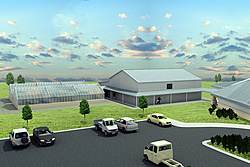This page has been archived and is being provided for reference purposes only. The page is no longer being updated, and therefore, links on the page may be invalid.
|
|
USDA Quarantine Facility to Help Control Invasive Pests
By Erin PeabodyMay 4, 2005
SIDNEY, Mont., May 4--U.S. Department of Agriculture officials broke ground here today for a quarantine-greenhouse complex. The new facility will allow government scientists to develop pesticide-free ways to control invasive plants currently threatening millions of acres of native rangelands across the western United States.
"The future complex includes a new greenhouse facility and will provide researchers with the appropriate lab environment and resources needed to safely study beneficial insects and other biological control agents," said Rodney J. Brown, agriculture deputy undersecretary for Research, Education and Economics.
"Invasive plants, including saltcedar, whitetop and leafy spurge, have the potential to displace native vegetation and siphon away precious water resources. They're also detrimental to the livestock and natural wildlife that depend on western rangelands," Brown said.
The planned 2,950-square-foot quarantine facility and 4,000-square-foot greenhouse space—estimated to cost $2.8 million dollars to construct—will augment the existing Northern Plains Agricultural Research Laboratory (NPARL) in Sidney that opened in 1963.
Senator Conrad Burns of Montana spoke at the 1 p.m. groundbreaking ceremony.
Sixteen scientists and 20 support staff will use the future laboratory and greenhouse facilities to study candidate insects and plant pathogens that show promise against hardy rangeland weed invaders. Entomologists and other specialists will be able to rear imported natural enemies of weeds, extract their DNA and evaluate their potential impacts on host and non-host plants all under one roof. This should expedite the process by which the scientists test and obtain approval to release organisms for use as biological control agents.
In addition to sharing research findings with producers and the agricultural industry, NPARL also maintains close ties with regional land-grant universities, which will also benefit from the research made possible by completion of the new facilities.
Sidney scientists have already made solid headway in controlling the invasive weed known as leafy spurge. In 1997, they kicked off the agency's first 5-year, areawide integrated pest management program targeting a rangeland weed. This biologically based program has successfully knocked down leafy spurge populations by 10 to 80 percent at most of the sites where spurge-feeding flea beetles were released, saving producers thousands of dollars and allowing native vegetation to recover.
Other NPARL research is focused on insect pests-such as grasshoppers and Mormon crickets-which in outbreak years cause extensive damage, destroying croplands, native vegetation and ornamental plants. Another major initiative is to investigate irrigation methods that can support value-added crops in the Montana-Dakota region, while conserving valuable water and soil resources.
NPARL is part of the Agricultural Research Service, USDA's chief in-house scientific research agency.

